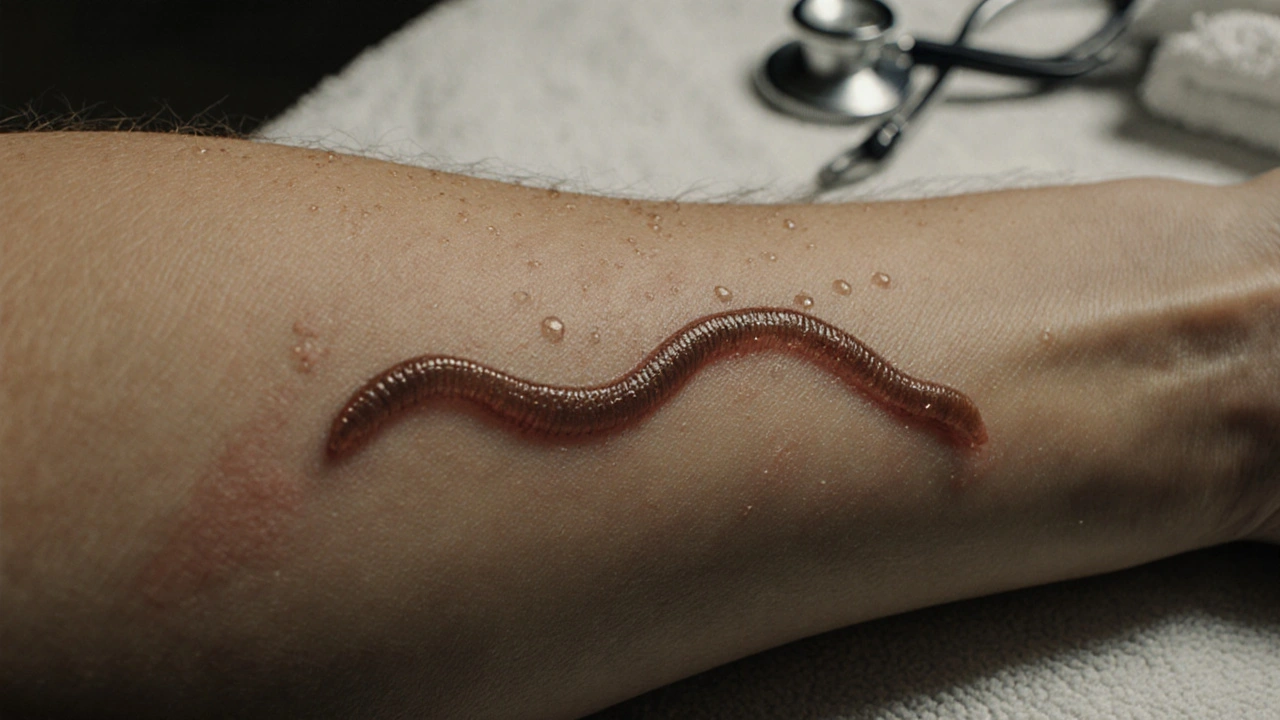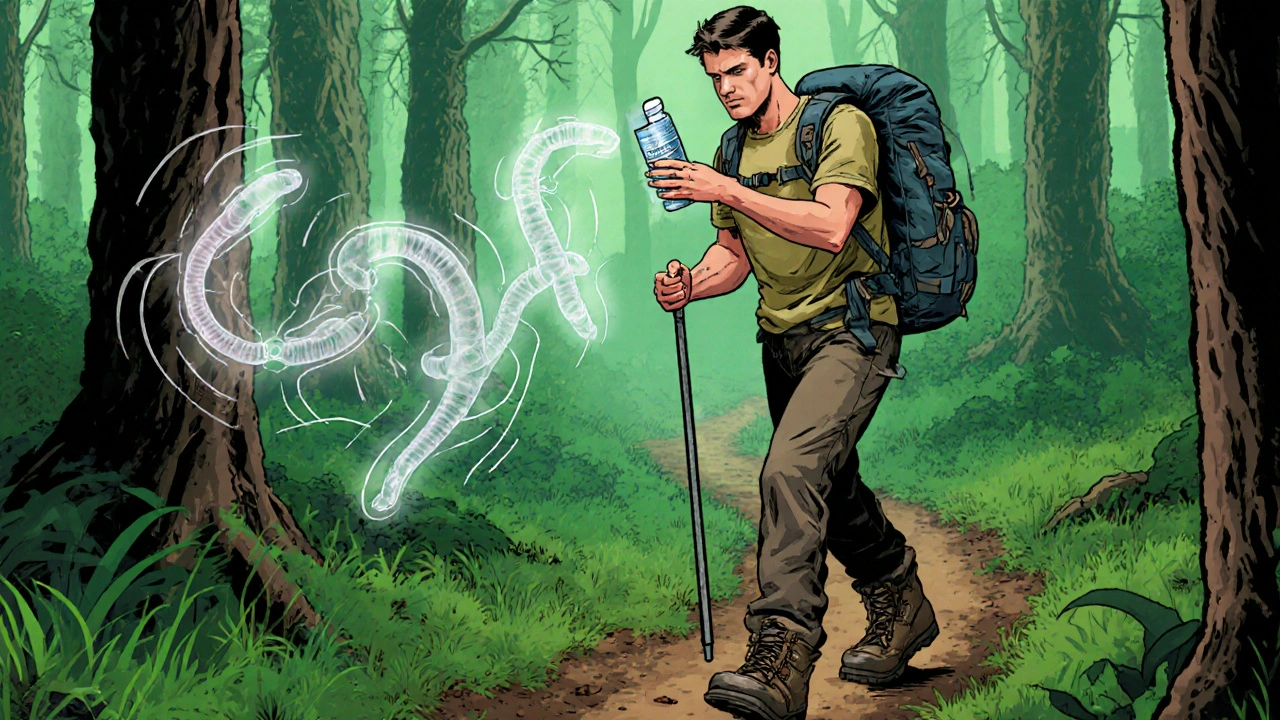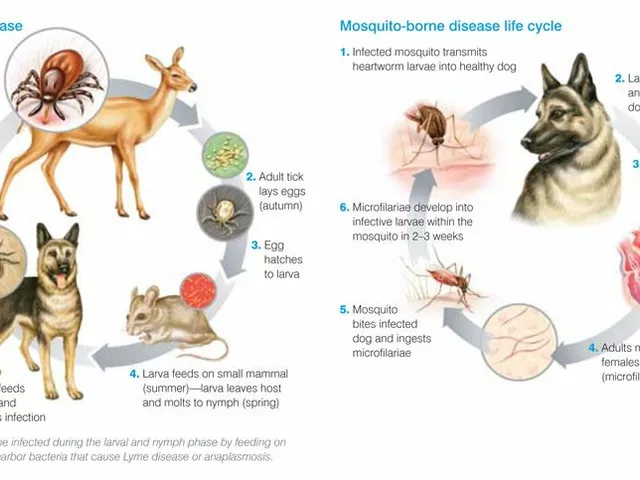
Skin Parasite Identifier
Describe Your Symptoms
Exposure History
Additional Information
Result:
TL;DR
- Several parasites can actually live inside or just under the skin, causing intense itching, crawling sensations, or visible lesions.
- Common culprits include hookworm larvae (cutaneous larva migrans), the Guinea worm, scabies mites, fly larvae (myiasis), and the African eye worm.
- Symptoms range from serpiginous tracks to painful nodules that burst with fluid or even worms.
- Diagnosis usually needs a skin scrape, blood test, or a careful visual inspection.
- Treatment often involves a single dose of antiparasitic medication, proper wound care, and preventive steps like wearing shoes and using insect repellent.
What makes a parasite a "skin" parasite?
When we talk about skin parasites, we’re referring to organisms whose life‑stage lives on, under, or inside the epidermis or dermis for at least part of their development. Unlike gut worms that stay inside the intestines, these critters either crawl just below the surface or embed themselves deep enough to lay eggs that eventually hatch in the skin.
Cutaneous Larva Migrans - the "creeping eruption"
Cutaneous larva migrans is a skin disease caused by the larval stage of animal hookworms such as Ancylostoma braziliense and Ancylostoma caninum. The larvae slip through the skin, usually after you walk barefoot on contaminated sand or soil, and then wander a few millimetres a day, leaving a red, winding trail that itches like crazy.
The rash is called a "creeping eruption" because it looks like a slow‑moving snake. A simple skin scrape examined under a microscope confirms the diagnosis. A single dose of ivermectin or albendazole clears the infection within 24‑48 hours.
Guinea Worm - a painful emergence
Dracunculus medinensis (commonly known as the Guinea worm) spends most of its life in freshwater copepods. When a person drinks water containing infected copepods, the larvae penetrate the gut, mature, and eventually travel to the lower limbs. About a year after infection, a female worm creates a painful blister on the skin, usually on the foot, and begins to emerge, releasing thousands of larvae into the water.
People often see the worm as a thick, white strand dangling from the blister. The worm is manually extracted by winding it around a stick over several days. Modern eradication programs rely on filtering drinking water and educating communities, which has reduced cases from millions to a handful per year.
Scabies Mite - a tiny egg‑layer under the skin
Sarcoptes scabiei (the scabies mite) burrows into the upper epidermis, creating microscopic tunnels where it lays eggs. The mite itself is invisible to the naked eye, but the tunnels appear as tiny, raised lines. Intense itching worsens at night because the female mite releases allergens that trigger a hypersensitivity reaction.
A skin scraping examined under a microscope reveals the mite, its eggs, or its fecal pellets. Treatment with 5% permethrin cream applied overnight, or oral ivermectin for resistant cases, kills the mites and stops the cycle.
Myiasis - fly larvae that turn your skin into a home
Dermatobia hominis (the human botfly) is a classic cause of myiasis. An adult botfly captures a mosquito, lays its eggs on the mosquito’s abdomen, and then the mosquito lands on a human. The warmth triggers the eggs to hatch, and the tiny larvae pierce the skin, forming a furuncle that breathes through a tiny opening.
Other flies, like the blowfly Cochliomyia hominivorax, can cause wound myiasis, colonising open cuts or necrotic tissue. The larvae are usually removed by suffocating them with petroleum jelly, then gently pulling them out. Systemic ivermectin can be used for extensive infestations.

Loa Loa - the eye‑worm that migrates under the skin
Loa loa (the African eye worm) is a filarial nematode that lives in the subcutaneous tissue of people in West and Central Africa. Adult worms can grow up to 7cm and migrate across the skin, sometimes crossing the conjunctiva of the eye, which is why sufferers describe a fleeting, itchy sensation.
Blood smears taken during the day show microfilariae, while ultrasound can visualise adult worms moving under the skin. The drug diethylcarbamazine (DEC) effectively kills both adult worms and microfilariae, but treatment must be supervised because rapid killing can trigger severe allergic reactions.
Onchocerca Volvulus - river blindness’s skin stage
Onchocerca volvulus (the river‑blindness worm) forms nodules under the skin where adult females release millions of microfilariae. These microfilariae migrate to the skin and eyes, causing intense itching, depigmented patches, and eventually blindness.
Skin snips examined under a microscope reveal the microfilariae. The WHO‑approved regimen of ivermectin, given once or twice a year, kills microfilariae and reduces skin symptoms, while doxycycline targets the Wolbachia bacteria that the worms depend on, eventually sterilising the adults.
Sparganosis - tapeworm larvae that form sub‑cutaneous lumps
Sparganosis (caused by the larval stage of the tapeworm Spirometra) occurs when people eat undercooked frog or snake meat, or drink water contaminated with infected copepods. The larvae migrate through the tissues and often settle in the sub‑cutaneous layer, forming hard, painful nodules that may exude a clear fluid if they die.
Diagnosis relies on imaging (ultrasound or MRI) that shows a tubular structure, and serology can confirm exposure. Surgical excision of the nodule removes the larva, and praziquantel can be given to kill any remaining parasites.
Quick comparison of skin‑dwelling parasites
| Parasite | Life‑stage in skin | Typical entry route | Main symptom | Common region |
|---|---|---|---|---|
| Cutaneous larva migrans | Hookworm larvae | Skin contact with contaminated sand/soil | Serpiginous, itchy track | Tropical beaches, SE Asia, Caribbean |
| Guinea worm | Adult female emerging | Drinking water with infected copepods | Painful blister with worm | Africa (Sudan, Ethiopia) |
| Scabies mite | Adult female burrowing and laying eggs | Skin‑to‑skin contact | Intense nocturnal itching | Worldwide, crowded settings |
| Human botfly (Dermatobia hominis) | Larvae feeding under skin | Mosquito‑carried eggs | Furuncle with breathing hole | Central & South America |
| Loa loa | Adult worm migrating | Bite of infected deerfly | Transient swelling, eye involvement | West/Central Africa |
| Onchocerca volvulus | Adult nodules releasing microfilariae | Blackfly bite | Itchy papules, skin depigmentation | River basins of Africa |
| Sparganosis | Larval tapeworm in sub‑cutis | Ingesting raw frog/snake or contaminated water | Hard nodules, occasional discharge | East Asia, parts of Russia |
How to protect yourself
- Wear shoes on beaches and in tropical soils to stop hookworm larvae from penetrating.
- Filter or boil water before drinking, especially in rural Africa.
- Apply insect repellent (DEET or picaridin) and cover exposed skin when travelling to endemic regions.
- Avoid sharing bedding or clothing with someone who has scabies.
- Promptly clean and dress any wounds; keep them covered to deter fly‑larvae infestation.
When to see a doctor
If you notice a rapidly moving skin track, a painful blister with a visible worm, persistent itching that disrupts sleep, or any unexplained sub‑cutaneous lump, schedule a visit. Early diagnosis prevents complications and reduces the chance of spreading the parasite to others.
Frequently Asked Questions
What is cutaneous larva migrans and how is it treated?
It’s a skin infection caused by animal hookworm larvae that crawl under the skin, leaving an itchy, winding rash. A single dose of ivermectin or albendazole stops the migration within a day.
How does the Guinea worm emerge from the skin?
After about a year in the body, the female worm creates a blister, usually on a foot, and pushes out a thin strand. The worm is slowly wound around a stick over several days until fully extracted.
Can scabies mites lay eggs inside the skin?
Yes. The female scabies mite burrows a few millimetres into the epidermis and deposits eggs in the tunnel, which hatch and cause the characteristic itching.
What should I do if I suspect a botfly larva under my skin?
Cover the breathing hole with petroleum jelly to suffocate the larva, then gently extract it with tweezers. If the lesion is large or multiple, see a clinician for surgical removal or oral ivermectin.
Are there any vaccines against skin parasites?
Currently no licensed vaccines exist for the parasites discussed. Prevention relies on hygiene, vector control, and safe water practices.
How long does it take for a Loa loa worm to move across my skin?
Adults can travel several centimetres per day, so you may notice a swelling that appears, moves, and disappears within hours.

Wrapping up
Skin parasites are rare, but when they do appear they can be unsettling. Knowing the signs, how each organism gets under your skin, and the right treatment can turn a scary crawl‑under‑the‑skin story into a quick fix. Keep your feet covered, drink clean water, and don’t hesitate to get professional help if you spot a strange track or a bubbling blister. The more you understand these unusual cases, the better you can protect yourself and others.
10 Comments
Write a comment
More Articles

Chlorthalidone FAQs: Everything You Need to Know
In my latest blog post, I've covered everything you need to know about Chlorthalidone, a popular medication for treating high blood pressure. I've answered frequently asked questions regarding its usage, side effects, and effectiveness. Additionally, I've discussed important interactions with other medications and lifestyle changes that can enhance its benefits. I've also shared some tips on how to safely incorporate Chlorthalidone into your daily routine. Don't miss this informative post if you or a loved one is considering using Chlorthalidone for better health management!

Tick Fever: What You Need to Know About This Dangerous Disease
Tick Fever, also known as Tick-Borne Disease, is a serious illness transmitted by ticks. It's crucial to be aware that this disease can have severe health implications including fever, headache, and fatigue, and in some cases can even be fatal. Early detection and treatment are absolutely vital. It's also important to take steps in preventing tick bites, such as using repellents and wearing appropriate clothing when in tick-infested areas. Stay safe out there, folks!

Manufacturing Transparency: How to Access FDA Inspection Records
Understand how FDA inspection records work, what manufacturers must disclose, and how internal audits differ from required quality investigations. Learn what triggers inspections, how to respond to Form 483, and why remote assessments are changing compliance.
Jocelyn Hansen
September 29, 2025 AT 19:23Hey everyone! 🎉 If you’re itching out of control, you’re not alone – the skin is a battlefield and you’ve got the right gear now!! Keep those shoes on the beach, filter that water, and remember: knowledge is the best anti‑itch cream!! 🌟 Stay curious, stay safe, and let’s squash those parasites together!!!